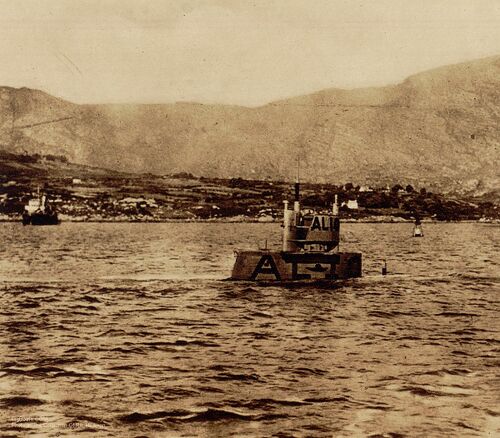L-10

Compared to today’s submarines that have a almost unlimited patrol time, these vessels were only capable of an average patrol of about 10 days. These boats had little food and freshwater storage and no refrigeration or air conditioning. Bathing and toilet facilities consisted of an open bucket. They were constantly damp inside making it nearly impossible to dry clothing. All of this severely affected the living conditions and limited the crew's endurance.
On one patrol the L-10 was heavily depth charged by the American destroyer USS Sterett (DD-27) in the Irish Sea after the submarine had developed an oil leak. The Sterett thought she had found a German U-boat. L-10 managed to surface and identify herself before the destroyer was able to use her guns to try and sink her.
Photo in the private collection of Ric Hedman.

L-10 with signal flags flying sailing past an American battleship, probably the USS Nevada (BB-36) in Bantry Bay, Ireland, summer of 1918.
Photo in the private collection of Ric Hedman.

L-10 loading a Bliss-Leavitt Mk 7 Mod 0 torpedo at her berth in Bantry Bay, Ireland, 1918. A rope and pulley system was attached to the periscope shears behind them, and the weapon was slowly winched down into the torpedo room and onto an inclined skid. Once fully inside the room the aft end of the skid was lowered to horizontal and the weapon/skid was pushed into position in the room.
Seen just forward and on either side of the open hatch are the three white painted heads of the K-tube passive sonar.
Photo in the private collection of Ric Hedman.
Page created by:
Ric Hedman & David Johnston
1999 - 2023 - PigBoats.COM©
Mountlake Terrace, WA, Norfolk, VA
webmaster at pigboats dot com
